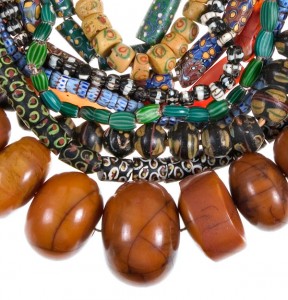I love using Moroccan Amber Beads in my jewelry, but, there are so many different types on the market, it can sometimes be a little challenging to work out whether or not you’re looking at the real deal. One of the primary causes for confusion is the notion (in some online circles) that copal amber is not real amber. Beads made from copal amber are usually labeled as “Amber Resin Beads”, “Copal Amber Beads”, or simply “Moroccan Amber Beads”. This would suggest, to those who don’t know, that they are probably genuine amber. And they are!
Copal amber, commonly sourced in Morocco and parts of Northern Africa, derives from the same fossilized tree sap as ‘real’ amber, however, is far younger in age. The price margin between the two is a prime indicator of age, as is the existence of inclusions, fossilized insects and fractures. Old amber ranges in color from burnt yellow to jet (caused by significant pressure), whereas copal amber is commonly yellow, orange and sometimes red. You can check whether your beads are made from copal amber by simply applying a little denatured alcohol to the surface with a cotton bud. Copal amber will become sticky, whereas natural old amber will not.
Man-made, or ‘fake’ amber can be made from a variety of materials; most commonly glass, celluloid, casein and plastic. With some varieties, it is possible to discern the difference by looking at them. For example, with plastic ambers, the inclusions are often too big to be genuine; they sometimes have a visible seam, and are often cloudier in color. Amber Beads made from casein and celluloid are a little more difficult to distinguish from the genuine article unless you hold them over a naked flame. Both casein and celluloid will usually give off a plastic smell.
You could also attempt the “hot needle” test. Simply heat a needle over a naked flame and insert into an inconspicuous part of the bead (perhaps around the perforation hole). Real amber will crack when pierced with a hot needle, whereas plastic will not. Genuine amber will also emit a pine-like or sweet scent, whereas man-made amber will give off a conspicuous chemical smell.

 African beads, trade beads, and antique beads have been enjoyed by many for centuries. African beads are treasured for their history. Many have traveled over 3 continents and can be up to centuries old. This blog is devoted to providing you with accurate information on African beads, trade beads, and antique beads. We hope you enjoy our blog!
African beads, trade beads, and antique beads have been enjoyed by many for centuries. African beads are treasured for their history. Many have traveled over 3 continents and can be up to centuries old. This blog is devoted to providing you with accurate information on African beads, trade beads, and antique beads. We hope you enjoy our blog!